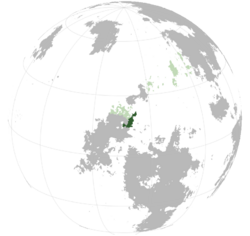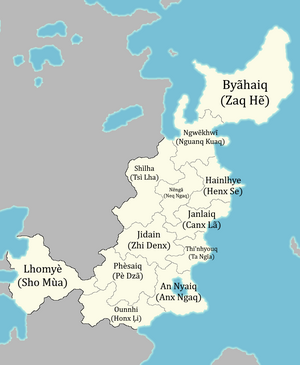Difference between revisions of "Archive:Angnyaiq"
| Line 68: | Line 68: | ||
|area_label2 = <!--Label below area_label (optional)--> | |area_label2 = <!--Label below area_label (optional)--> | ||
|area_data2 = <!--Text after area_label2 (optional)--> | |area_data2 = <!--Text after area_label2 (optional)--> | ||
|population_estimate = | |population_estimate = 7,800,000 | ||
|population_estimate_rank = | |population_estimate_rank = | ||
|population_estimate_year = | |population_estimate_year = 20XX | ||
|population_census = | |population_census = | ||
|population_census_year = | |population_census_year = | ||
Revision as of 01:17, 18 April 2023
| Angnyaiq Kwang: Annyaiq/見仙 Angnyaiq Kwang: Anx Ngaq Standard Pan-Ambaroid: TBD |
||||
|---|---|---|---|---|
|
||||
Angnyaiq within the Draconic Alliance
|
||||
| Capital and | Angnyaiq | |||
| Official languages | Standard Kwang, Angnyaiq Kwang, Standard Pan-Ambaroid | |||
| Demonym | Angnyaiq | |||
| Government | Presidential parliamentary republic | |||
| - | President | X | ||
| Area | ||||
| - | 224,832.75 km2 86,808 sq mi |
|||
| Population | ||||
| - | 20XX estimate | 7,800,000 | ||
Angnyaiq (Standard Kwang: An Nyaiq [ã́ ɲɛ̄ˀ], Angnyaiq Kwang: Anx Ngaq [ɐ̃́x ŋɐ̀ˀ], Standard Pan-Ambaroid: [X]), officially the Angnyaiq Second Republic, is a nation located in Northeast Nagu bordering the nations of Goal and Nanghung. A former Qonklese colony and member of the Draconic Alliance, Angnyaiq is one of the most developed countries in Nagu, following the modernization efforts of the X Revolution, the country enjoyed (some other good stuff) and significant foreign investment.
Etymology
Angnyaiq is derived from Middle Kwang ang ‘see’ + ñaq ‘spirit’. Angnyaiq and Nagu in general was believed to be as a continent home to the gods, where the heavens connected with the earth.
History
Prehistory
Ancient history
Blah uhhh, there's not much I can offer here before 500CE. Around 500CE, the first reports of the Ambaroid people begin to appear in Dhweran trading records. The First Dhweran Empire traded minimally with the peoples of the region, however they established the first trading post in the area, though it was quickly abandoned.
Qonklese colonization
In 1705, a group of traders from eastern Qonklaks established a trading post in Angnyaiq. There was no official name for the post, though eventually the name Angnyaiq became used for the trading post and the area surrounding. Throughout the early 18th century, careful advertising and cheap offers of land lead to fast growth of the post, and it eventually became a large, primarily Kwang speaking settlement. In 1733, numerous plantations started up, growing valuable cash crops such as X, bringing even more wealth to the growing city. The growth was so significant, it attracted laborers from all over Boroso, Qonklaks, and Nagu. Eventually, the powers of the modernizing Qonklaks and the maritime power of Dhwer. In 1782, the Qonklese officially put Angnyaiq under the protection of the Emperor, and informally annexed it. This drew extreme negative attention from Dhwer, sparking the Quonco-Dhweran War, fought in the Dragon Sea.
19th century
20th century
By the turn of the century, Angnyaiq remained under Qonklese control, however during this time, mismanagement of administration lead to increased dissatisfaction among the influential trading families who existed since the early years of colony. Though no longer trade-reliant, they held extreme political influence in the colony. During the chaos of the White Revolution in Qonklaks, numerous localist factions within Angnyaiq declared independence from Qonklaks, and four republics—Angnyaiq, Byãhaiq, Janlaiq, Hainlhye—were founded in 1902. The four republics defended their unique identity separate from traditional Qonklese culture, which facilitated the formation of the Quadruple Alliance against the Cananganamese Empire during the _ War in the 40s.
Geography
Geology
Climate
Biodiversity
Politics
Government
Angnyaiq is a presidential parliamentary republic based on the ideas of 20th century (some semi-kuulist movement).
Administrative divisions
Angnyaiq is a federal state divided into 12 Thein (Angnyaiq Kwang: Tianx) or "Themes," a word derived from the Classical Cananganamese word thémā. Each Theme is mostly(?) autonomous, though they all fall under the constitution of Angnyaiq.
| Theme | Capital | Population | Land area in km2 | Population density |
|---|---|---|---|---|
| An Nyaiq (Anx Ngaq) | ? | ? | ? | — |
| Byãhaiq (Zaq Hẽ) | ? | ? | ? | — |
| Hainlhye (Henx Se) | ? | ? | ? | — |
| Janlaiq (Canx Lã) | ? | ? | ? | — |
| Jidain (Zhi Denx) | ? | ? | ? | — |
| Lhomyè (Sho Mùa) | ? | ? | ? | — |
| Nẽngã (Neq Ngaq) | ? | ? | ? | — |
| Ngwẽkhwĩ (Nguanq Kuaq) | ? | ? | ? | — |
| Ounnhi (Honx Ļi) | ? | ? | ? | — |
| Phèsaiq (Pè Dzã) | ? | ? | ? | — |
| Shìlha (Tsì Lha) | ? | ? | ? | — |
| Thi'nhyouq (Ta Ngĩa) | ? | ? | ? | — |


